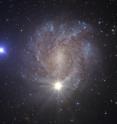Queen's astronomers discover fastest ever unbound star in our galaxy
Related images
(click to enlarge)
A fast-moving unbound star discovered by astronomers at Queen's University Belfast has broken the galactic speed record. The unbound star, named US708, is traveling at 1,200 kilometers per second -- the fastest speed ever recorded for such an object in our galaxy -- meaning it is not held back by gravity and will eventually leave the Milky Way.
US708 is believed to have once been part of a double-star solar system, which also included a massive white dwarf star. The white dwarf is thought to have turned into a 'thermonuclear supernovae' and exploded, kicking US708 and sending it hurtling across space.
The discovery of US708 sheds light on the mysterious double-star systems that give rise to thermonuclear explosions. Thermonuclear, or 'type Ia', supernovae have long been used to calculate the distances to faraway galaxies -- a measurement which helps to determine how the universe is changing and expanding.
Dr Rubina Kotak and Ken Smith, from the Astrophysics Centre at Queen's University, were part of a team of scientists from countries across the world who made the ground-breaking discovery using data gathered by the Pan-STARRS1 telescope on Mount Haleakala on the Hawaiian island of Maui. Using a range of data gathered over the last 59 years the team were able to determine the full 3-D motion of the star and measure how quickly it is moving across the plane of the sky.
Dr Rubina Kotak, from the Astrophysics Centre at Queen's University Belfast, said: "It is very exciting to have contributed to this important discovery which is a great example of Queen's commitment to achieving excellence and advancing knowledge for the benefit of society. It brings us a step closer to solving the type Ia puzzle."
European Southern Observatory fellow, Stephan Geier, who led the study, said: "Several types of stars have been suspected of causing the explosion of a white dwarf as supernova of type Ia. Until now, none of them could be confirmed. Now we have found a delinquent on the run bearing traces from the crime scene."
Queen's University Belfast is a full member of the PS1 science consortium, which carried out this research involving astronomers from ten other institutes dotted across the world. The research was led by Dr Stephan Geier, European Southern Observatory fellow, and comprised contributions from scientists from a number of countries including Germany, USA, the Netherlands, China and the UK.
Source: Queen's University, Belfast
Other sources
- Queen's Astronomers Discover Fastest Ever Unbound Star in Our Galaxyfrom Newswise - ScinewsWed, 11 Mar 2015, 4:50:05 UTC
- Fast-moving unbound star has broken the galactic speed recordfrom Science DailyWed, 11 Mar 2015, 1:10:16 UTC
- Observatory: Fastest Star in the Galaxy Got an Unusual Startfrom NY Times ScienceTue, 10 Mar 2015, 1:10:10 UTC
- Winds Blasting From Black Holes Shut Down Star Growthfrom National GeographicSun, 8 Mar 2015, 8:05:30 UTC
